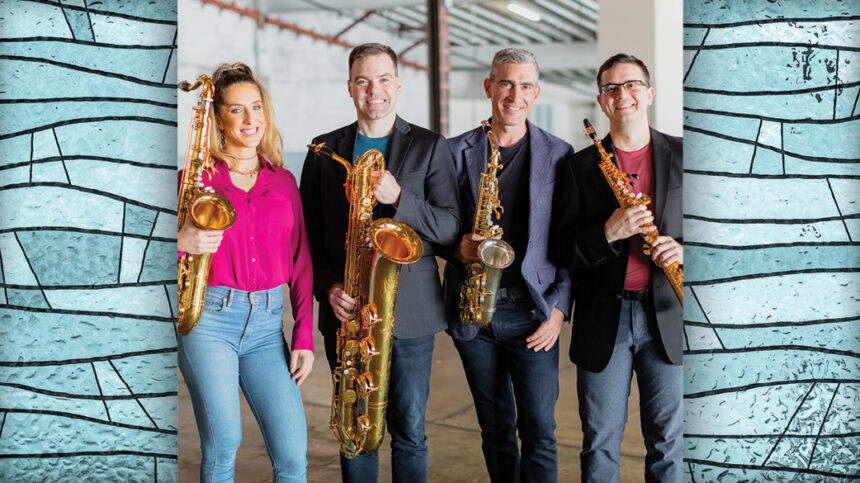Dannel Espinoza was just a tyke when he started the path that would become his forte. His parents offered the option of karate, baseball or piano when he was 3 1/2 or 4. “I decided to take up piano,” he said. The instrument became a staple of his south Florida childhood, until he reached school band age, took after his older brother, and took up the saxophone.
“We had a saxophone laying around the house and I always just found it really intriguing,” Espinoza said. “So, I picked it up then.” He hasn’t put it down since.
In MSO’s “Ultimate Fusion” concert April 13, he’ll revel in the rhythmic soundscape of Philip Glass’s Concerto for Saxophone Quartet and Orchestra, as soprano saxophonist in the acclaimed Project Fusion quartet. Espinoza, Assistant Professor of Saxophone at the University of Southern Mississippi, joins fellow quartet members Katherine Weintraub (tenor sax), Doug O’Conner (alto sax) and Matthew Evans (baritone sax) in the spotlight with MSO.
The concert program opens with Anatoly Lyadov’s The Enchanted Lake and closes with Dmitri Shostakovich’s monumental Symphony No. 5, with Glass’s concerto in the evening’s centerpiece.
The saxophone has long ranked favorite for Espinoza, who was also schooled in string instruments as well as French horn and gained broad instrument familiarity in his few years as a band director. “I’ve learned how to play just about every other instrument there is out there, and saxophone definitely feels the most like me.” In the arc of classical music, the sax is a relative latecomer to the orchestra — brash, energetic, injecting some real excitement into the mix.
“Out of all the instruments in the orchestra, saxophone is by far the youngest,” Espinoza said. “A lot of our music is still kind of finding its way out into the world… so it’s really fun to be a part of that.
“It almost feels like this free world, where everything that we’re working on could really become the next or the main defining piece of our instrument.”
He sees saxophonists as the most willing to try things and dive into new music, which can be very different, “some of it is kind of like squeaks and boops but other stuff is really melodic and just can be very beautiful,” he said. More bonuses: “We get to dabble a little bit in jazz, and we do have a foot in the pop world.” Project Fusion also does a lot of video game music and has played for video game audiences. “You get to dip your toes in different pools and make all sorts of different kinds of music.
“Even just the sheer physical fact of how you blow into the instrument, the way the saxophone is able to handle your airstream and the force, is really fun,” he said.
Project Fusion came together at Eastman School of Music in Rochester, N.Y. in 2010, as saxophonists who were previously competitors at separate schools became collaborators at the conservatory. “We were so curious as to what each other was doing in their other ensembles, that we came together to… essentially fuse our ideas together,” he said. They were part of the original Eastman Saxophone Project, a larger saxophone ensemble that performs everything completely from memory, without a conductor. Their Project Fusion title is a nod to both building blocks.
Even now, with Espinoza in Hattiesburg, O’Conner and Evans playing in the U.S. Army Band “Pershing’s Own” in Washington, D.C., and Weintraub teaching at the University of South Florida, Project Fusion manages to perform together at least a couple of times each month.
Glass’s concerto, now practically a standard, was written for the world-renowned Rascher Saxophone Quartet based in Germany and premiered in 1995. It first fell on Espinoza’s ears at a workshop the ensemble hosted in the U.S. “I just fell in love with it, from the first listen,” he said. There are two versions of the composition — one as the concerto with orchestra that will be featured with MSO, and another performable by just the quartet’s four musicians. “Of course, it’s a lot more colorful and impactful as a big orchestra concerto,” Espinoza said.
The concerto’s four movements range from exciting to deeply meditative, each with a different saxophone introducing the melody or theme. The soprano saxophone is featured first, with melodies that echo through all the other woodwinds. “You hear this transformation of colors throughout the entire piece.” The baritone saxophone steps up in the second movement, “just this groove machine,” Espinoza said. Next, in the third movement, “It is just the most beautiful tenor saxophone melody. … People can fall into a deep trance.” The fourth movement features the alto, “very fast-paced, with a lot of fast-flying arpeggios within all the instruments.”
Espinoza plays with MSO when the orchestra needs a saxophonist, and is wed to MSO harpist Kristina Finch. But this upcoming spotlight, in a love-at-first-listen masterpiece, is a sure-fire focus that brings saxophones front and center, highlighting all the verve, versatility and pure joy Project Fusion can wrest from them.

